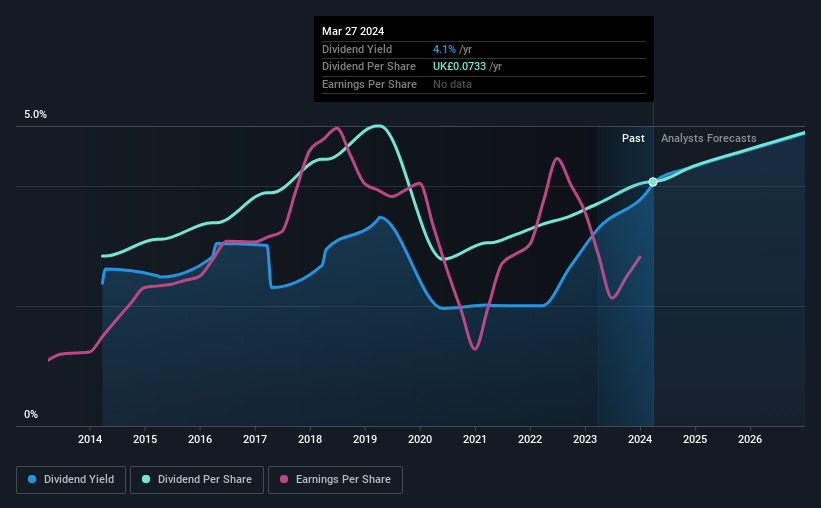- United Kingdom
- /
- Consumer Durables
- /
- LSE:BOOT
Henry Boot's (LON:BOOT) Dividend Will Be Increased To £0.044
Henry Boot PLC (LON:BOOT) will increase its dividend on the 31st of May to £0.044, which is 10.0% higher than last year's payment from the same period of £0.04. Based on this payment, the dividend yield for the company will be 4.1%, which is fairly typical for the industry.
Check out our latest analysis for Henry Boot
Henry Boot's Payment Has Solid Earnings Coverage
We like to see a healthy dividend yield, but that is only helpful to us if the payment can continue. Based on the last payment, Henry Boot was earning enough to cover the dividend, but free cash flows weren't positive. With the company not bringing in any cash, paying out to shareholders is bound to become difficult at some point.
EPS is set to fall by 5.3% over the next 12 months. Assuming the dividend continues along recent trends, we believe the payout ratio could be 40%, which we are pretty comfortable with and we think is feasible on an earnings basis.

Dividend Volatility
The company has a long dividend track record, but it doesn't look great with cuts in the past. Since 2014, the annual payment back then was £0.051, compared to the most recent full-year payment of £0.0733. This means that it has been growing its distributions at 3.7% per annum over that time. The dividend has seen some fluctuations in the past, so even though the dividend was raised this year, we should remember that it has been cut in the past.
Dividend Growth Is Doubtful
With a relatively unstable dividend, it's even more important to evaluate if earnings per share is growing, which could point to a growing dividend in the future. Henry Boot has seen earnings per share falling at 7.0% per year over the last five years. If earnings continue declining, the company may have to make the difficult choice of reducing the dividend or even stopping it completely - the opposite of dividend growth.
The Dividend Could Prove To Be Unreliable
Overall, this is probably not a great income stock, even though the dividend is being raised at the moment. With cash flows lacking, it is difficult to see how the company can sustain a dividend payment. We would probably look elsewhere for an income investment.
Market movements attest to how highly valued a consistent dividend policy is compared to one which is more unpredictable. At the same time, there are other factors our readers should be conscious of before pouring capital into a stock. As an example, we've identified 1 warning sign for Henry Boot that you should be aware of before investing. Is Henry Boot not quite the opportunity you were looking for? Why not check out our selection of top dividend stocks.
Valuation is complex, but we're here to simplify it.
Discover if Henry Boot might be undervalued or overvalued with our detailed analysis, featuring fair value estimates, potential risks, dividends, insider trades, and its financial condition.
Access Free AnalysisHave feedback on this article? Concerned about the content? Get in touch with us directly. Alternatively, email editorial-team (at) simplywallst.com.
This article by Simply Wall St is general in nature. We provide commentary based on historical data and analyst forecasts only using an unbiased methodology and our articles are not intended to be financial advice. It does not constitute a recommendation to buy or sell any stock, and does not take account of your objectives, or your financial situation. We aim to bring you long-term focused analysis driven by fundamental data. Note that our analysis may not factor in the latest price-sensitive company announcements or qualitative material. Simply Wall St has no position in any stocks mentioned.
About LSE:BOOT
Henry Boot
Engages in the property investment and development, land promotion, and construction activities in the United Kingdom.
Excellent balance sheet average dividend payer.
Similar Companies
Market Insights
Community Narratives



